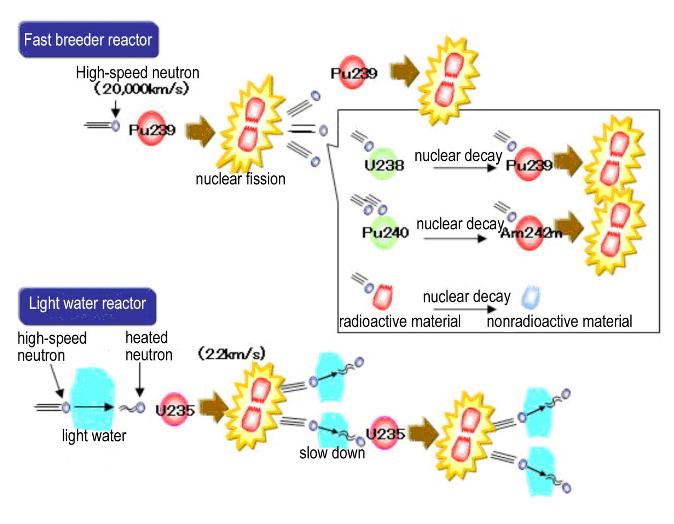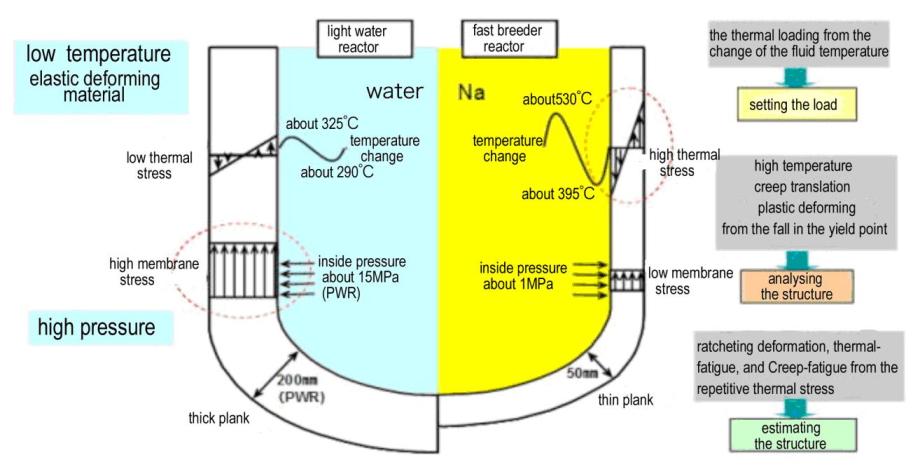| |
 |
Vol.37 Nuclear Engineering and Management |
|
|
|























|
Vol.37 Jun
Nuclear system of next generation
We interviewed Professor Naoto KASAHARA, who studies next-generation
nuclear system such as the new mechanism of nuclear reactor and future
image of nuclear power plants.
He was a member of Power Reactor and Nuclear Fuel Development Corporation
(now Japan Atomic Energy Agency) and involved in development of fast breeder
reactors.
Now, as the professor of the University of Tokyo, Graduate School of Nuclear
Engineering and Management, he is making a lot of efforts to train the
students who will shoulder further development of nuclear system in the
future.
Q. Could you explain the present mechanism of the nuclear reactors?
Most of the reactors now in use are “light-water
reactors.” Light water means normal water. It is made from mostly light
hydrogen (with a mass number of one) so it has lower density than heavy water (which
is made from only heavy hydrogen with a mass number of two). In a light-water
reactor, neutrons hit U235, one of the isotopes of uranium, and nuclear fission
takes place. Light water is used to slow down the high-speed neutrons to the
proper speed for the nuclear fission of the U235 atoms. |

Professor KASAHARA
Nuclear Engineering and Management |
Light water is used because it absorbs neutrons better than heavy water and
therefore it has a higher ability to slow down neutrons. The heat from that
fission changes water into steam which turns a turbine that generates
electricity.
However, U235 accounts for just only 0.7 % of natural uranium. Therefore
we are developing the “Fast breeder reactor” that can use other isotopes
of uranium and is expected to reduce radioactive waste.
Q. What is a “fast breeder reactor”?
In a fast breeder reactor, high-speed neutrons hit U238. (cf. in light
water one, slowed-downed neutrons hit U235). The speed of the neutron is
about 20,000 km/s. Radioactive decay of U238 takes place and it changes
into Pu239. Pu239 decays easily and emits two more neutrons. These neutrons again transform
U238 into Pu239. In this way nuclear fuel “breeds” other fuel. This process
enables high efficiency use of fuel. Additionally, high-speed neutrons also hit
other radioactive materials and cause radioactive decay. These radioactive
materials are transformed into materials with shorter half-lives and soon lose
their radioactivity, reducing radioactive waste.

Fig.1:Diference between fast breeder reactor and light water reactor in
nuclear fission
Q. Could you explain your own research?
The energy efficiency of nuclear power systems rises when the temperature becomes higher. While the temperature in a light-water reactor is about 300℃, the fast breeder reactor is planned to operate at more than 500℃. I’m studying fast breeder reactor systems that can operate at even higher temperatures, aiming practical use. But one of the biggest problems is the stress on the reactor. Fast breeder reactors use liquid metal which doesn’t slow down neutrons like water does, conducts heat efficiently, and doesn’t boil even at high temperatures. Popular liquid metals include mercury and lead, but in this reactor pure sodium is used because it doesn’t corrode other metals. Liquid metal doesn’t cause as much stress on the reactor because it doesn’t change volume so greatly with temperature, though of course there is some pressure because of the pressure differential from the outside to the inside of the reactor.
Q. Then what cause the stress on the reactor?
When you pour hot water into a cold cup, the inside of the cup gets hot and expands its volume but the outside doesn’t. That causes stress in the cup, which might then break into pieces. The same may happen with the reactor. The problem is not the fact that the reactor is hot but the temperature differential between the inside and the outside of the reactor. If the temperature rises gradually, this would be no problem. But sometimes we have to stop the reactor suddenly in the case of an emergency. So we must design the reactor so that it can endure great thermal stress. In addition, the stress is concentrated in particular parts of the reactor.
The parts in which stress is concentrated differ according to the shape of the machine, so we have to consider the strength of a complex-shaped machine. Moreover there is another problem. When metal becomes hot, its shape can be easily become distorted. When a candy becomes hot, it becomes soft and its shape can change easily. This fact is called the “creep phenomenon.” This phenomenon occurs to metal at quite a high temperature. If this phenomenon occurs to the machine repeatedly, serious distortions or cracks may result.

Fig.2:Diference between fast breeder reactor and light water reactor in
pressure
Q. What is the benefit of using liquid metal?
As I said before, high-speed neutrons are needed in order to cause the radioactive decay of uranium in a fast breeder reactor, and liquid metal is a medium that doesn’t slow down neutrons. If the density of nuclear fuel is low, neutrons easily pass through the openings in the fuel, resulting in a low efficiency of nuclear fission and nuclear translation. On the other hand, if the density is high, these problems are solved but then it cannot emit the heat. So liquid metal, which has high heat conductivity, solves this problem.
Q. What motivate you the most to study nuclear reactor?
I feel very happy when the knowledge gained from my research is applied to an actual reactor and contributes to society. Before being adopted as a standard, many people who are involved in the development of the reactor examine it. Besides, we also ask the public for their opinions. Consequently, the standard is worth trusting and I feel honored to be involved in setting the standards.
Q. What do you think is necessary for the widely use of atomic power?
For the spread of atomic power, I think it is most important that people think personally about the balance between the merits of generating lots of electricity and the associated risks. In Japan there are a lot of demands for safety and people are unwilling to introduce fast breeder reactor technology, but this new technology will be indispensable for the stable supply of electricity in the future. We have to explain the risks of atomic power so that the public can properly understand this issue.
Q. Do you have a message for students?
I think it’s important to see things from a broad perspective. You should decide which way to go after considering carefully whether or not what you’re doing or going to do is really useful. Studying for setting the standard might seem to be boring compared to studying something new and writing papers about it. However, in the long run, we gain a lot of pleasure by contributing to society. Be a person who sets their goal after seeing from a broader perspective, and sooner or later you will earn great fruits from your efforts that also bring you great pleasure and satisfaction.
|
東京大学工学部・大学院工学系研究科 広報室学生アシスタント
(C) 2007-2011 University of Tokyo, Public Relations Office Assistants All
Rights Reserved |
|